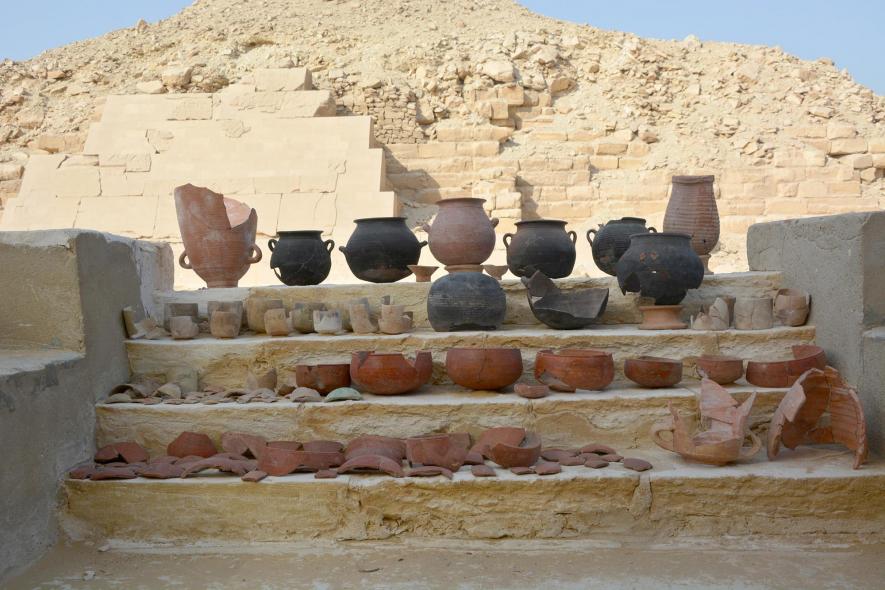Egyptian Mummies: Archaeologists Uncover Chemicals Used to Embalm Mummies

Image source: Internet; used for representation only.
New Delhi: Archaeologists claimed to have uncovered mysteries about the Egyptian Mummies. Their discoveries have revealed many important aspects of how the mummies were prepared including the unique chemicals used on them to preserve them for a long time.
Archaeologists working at the Saqqara necropolis in Egypt discovered a 2500-year-old mummy-making workshop or an embalming workshop along with an adjoining burial shaft and five mummies. Here at the site, the archaeologists discovered the sarcophagi, mummy masks, and gilded silver that provide a wealth of knowledge about how the mummies were prepared in ancient times. A sarcophagus is like a coffin where leaders and wealthy people in ancient Egypt were buried. Most of the sarcophagi were made up of stone and commonly displayed over the ground.
In the embalming workshop, the researchers also found labelled pots used in embalms. These pots have also revealed the chemicals that the ancient people used in preparing the mummies, which are mostly plant and animal extracts. Some of the ingredients originated hundreds or thousands of kilometres away from the site. These findings have been reported in a paper published in Nature on February 1. From the chemical analysis of the contents of the labelled pots, they found that mostly they were a complex mixture of resins extracted from plants, some of which grew as far as Southeast Asia.
Commenting on the findings, Dr Ramadan Badry Hussein, the director of the Saqqara Saite Tombs Project that oversees the excavation at the Saqqara site commented in a statement, “ We are standing before a goldmine of information. This discovery is so important as its extensive. We have oils and measuring cups – all of them are labelled … from this, we can find the chemical composition of the oils and discover what they are.”
The excavated embalming workshop and the burial shaft just 30 meters’ away date back to 664-404 BC (the Saite Persian period). These also give clues about the status of the ancient inhabitants. “There are clear socioeconomic differences between the mummies in the shaft. We see that mummification happened above ground, while some of those buried down there were either buried in private or shared chambers,” Dr Hussein commented further.
Earlier, the embalming process was understood from two main sources of information, which are historical texts and chemical analysis of the mummies themselves. However, deciphering accurately about the ingredients was difficult—“You might have the name of something, but you don’t know what the hell it is, except the hieroglyphics suggesting it’s an oil or a resin,” said Salima Ikram, a specialist in mummies at the American University, Cairo, explaining the gaps in linking the knowledge from the two sources.
In the Saqqara embalming workshop, the researchers could obtain the pots that contained labels describing the ingredients in them. This is the first time, researchers could discover the jars or pots that describe the ingredients.
The underground embalming workshop was discovered in 2016 at Saqqara. Notably, Saqqara was an ancient burial ground of Egypt that is in use since 2900 BC or even earlier. The team of researchers, which is an Egyptian-German team, used the technique known as gas chromatography-mass spectrometry at a National Research Laboratory Centre situated in Giza of Egypt. Their analysis found that the pots contained extracts from cypress trees, juniper bushes and cedar trees, that grow in the eastern Mediterranean region. Along with this, the team also found animal fats and beeswax and bitumen.
Two surprising ingredients that the researchers found in their analysis were one particular resin known as elemi and dammar being the other one. Importantly, elemi comes from Canarium trees, which grow in rainforests of Asia and Africa and dammar comes from Shorea trees which are found in tropical forests of southern India, Sri Lanka and Southeast Asia.
The researchers say that those involved in the process of embalming had a sophisticated understanding of the ingredients and their properties. They found that some of the ingredients in the pots were carefully heated or even distilled. Many of the resins used had antimicrobial properties. Co-author of the report published in Nature, Maxime Rageot commented that their knowledge of these substances was incredible. Rageot is a biomolecular archaeologist at the University of Tubingen, Germany. However, researchers remain unclear about the choice of the combination of substances used in the mummies by ancient Egyptians.
Get the latest reports & analysis with people's perspective on Protests, movements & deep analytical videos, discussions of the current affairs in your Telegram app. Subscribe to NewsClick's Telegram channel & get Real-Time updates on stories, as they get published on our website.















